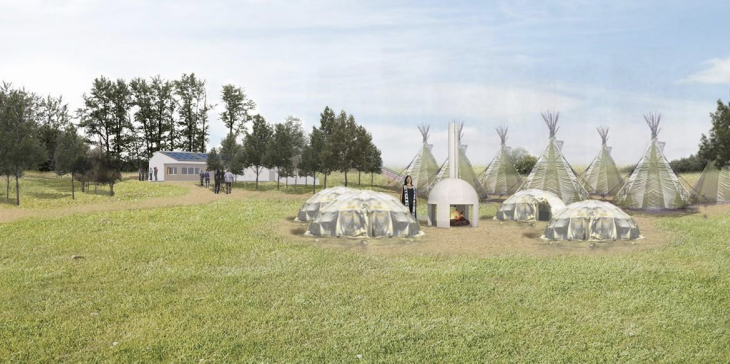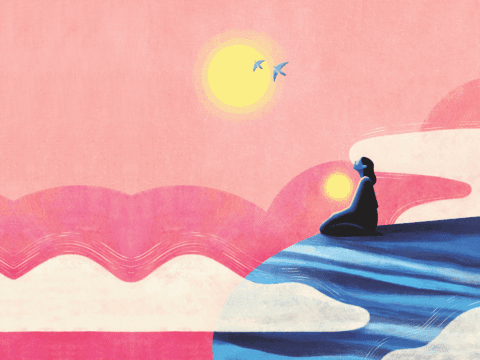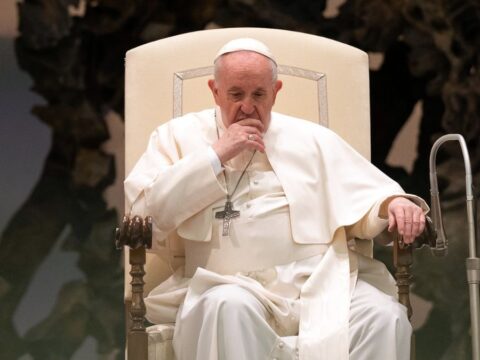Next month, construction will finish on a permanent, urban Indigenous ceremonial site in Edmonton. Called kihciy askiy — Cree for sacred land —sweat lodges, pipe ceremonies, traditional teachings and land-based learning will happen here. The first project of its kind in the country, the site includes four sweat lodges, tipis, a pavilion and a gathering area, all centrally located in Edmonton’s River Valley. An opening date has not yet been set.
Project manager Lewis Cardinal, who is Woodland Cree, has pushed for the site’s creation over the past 16 years. The project started after an international conference on healing and traditional Indigenous knowledge was held in Edmonton and elders asked Cardinal for help finding a space to hold ceremonies for the event. Cardinal shared the location where kihciy askiy now stands, leading the elders to wonder if such a place could always be available.
You may unsubscribe from any of our newsletters at any time.
Early on, a group of 120 Indigenous elders from across Alberta were brought together to guide the project. “One of the most important things that the elders stated is that we need to have access to these ceremonies for developing a strong identity, which will contribute to healthy living and stronger communities,” Cardinal says. A smaller Counsel of Elders has continued to provide guidance.
The final $6.5-million project is a partnership between the local Indigenous Knowledge and Wisdom Centre, which will operate the site, and the City of Edmonton. Cardinal spoke to Cailynn Klingbeil about kihciy askiy.
Cailynn Klingbeil: Why is a place like this needed in Edmonton?
Lewis Cardinal: The site is a place where Indigenous ceremonies and cultural gatherings can take place. Indigenous people in Edmonton have to leave the city in order to do these basic ceremonies, and so now we no longer have to do that. We have over 60 Indigenous organizations that serve the Indigenous community in Edmonton and each of them have cultural and ceremonial programming, and they all have to leave the city in order to accomplish and deliver those things. Now, they won’t have to go very far.
CK: Where is kihciy askiy located and why was that site chosen?
LC: The location is five or six kilometres, as the crow flies, [from] the centre of the city, and it’s nestled in Whitemud Park. The Blackfoot and the Cree have oral histories of going to that location to mine ochre, a mineral used in ceremonies. And the Whitemud Creek itself has banks that have white mud in them, and that white mud has ceremonial value. It’s been used in a lot of ceremonies by Indigenous peoples from different nations, particularly, in one case, the rite of passage for Cree women.
We have archaeological evidence of various campfire pits here, and we found, just recently, 900-year-old buffalo horns. It’s a significant location, and it’s also accessible by public transit. That’s a really big thing, for our families and community members, to be able to access it simply by taking a local bus to the site.

CK: What are some of the ceremonies that will take place at kihciy askiy?
LC: Sweat lodges and pipe ceremonies and various cultural activities will be hosted. Our purpose is to create a space where different Indigenous nations, with different languages, customs and traditions, can do their own ceremonies. That way, they can serve their populations and transfer their own particular kind of Indigenous knowledge and wisdom. That’s what makes this project unique; we’re not just centered on one Indigenous nation.
More on Broadview:
- Sask. program links Indigenous land users with settler farmers
- Day school survivors need access to United Church archives
- How I have found healing in remembering sacred Indigenous teachings
CK: Can you describe what sweat lodges are, as well as pipe ceremonies?
LC: Sweat lodges are purification ceremonies, and they’re also ceremonies for prayer. It’s something that’s as old as the sun, in terms of the ceremonies that we have. So it’s a place that you go into, in the form of a rounded hut. The centre of that sweat lodge is a pit that contains heated rocks — red hot — that are heated on an outside fire pit and then brought into the sweat lodge. And then there’s songs that are sung and prayers that are offered and given. Physiologically, it’s a very refreshing and healthy activity to participate in, and it also comes with a lot of shared teachings, wisdom and knowledge.
There’s so many different types of pipe ceremonies. We can use the pipe ceremonies to begin dialogue circles, healing ceremonies, conflict resolution ceremonies. The pipe holders each have their own pipes, and they circulate that amongst the people gathered in a circle. Depending on what the purpose of the pipe ceremony is, the prayers offered are focused on that particular business. It’s not required for people to actually smoke the tobacco. All you have to do is touch the pipe and move it on to the next person.
CK: Will the general public also have access to kihciy askiy?
LC: Yes. Already, we’ve been called on by organizations and agencies, to come out with their staff and do some ceremonies. The elders have also instructed me to develop a general public program, where we can have sweat lodges or pipe ceremonies or history circles, that sort of thing. I also do a lot of work with the Edmonton interfaith community, and have been in dialogues with the Jewish Seniors’ Centre and a couple of the temples in the Edmonton area. They want to create a program specifically for their congregations to be able to learn more of Indigenous traditions and knowledge.
Below: A ground blessing ceremony held at the kihciy askiy site last September
CK: When kihciy askiy opens, what are you most looking forward to?
LC: I’ve had this vision for quite awhile, since we started this. What I saw in this vision was a young man with a rolled-up towel under his arm, standing in front of the shopping centre in downtown Edmonton. And he’s standing there with his mother and his little sister, and a person notices them standing there and notices the towel under his arm. They ask him, ‘So where are you going swimming?’ And he goes, ‘I’m not going swimming, I’m going to a traditional sweat lodge at kichiy askiy. And I’m bringing my mom and my sister because they’ve never been to one before.’
And that’s what I’m looking towards: the opportunity for the young people to be able to be introduced to their culture and their traditions, by Indigenous people in an Indigenous environment with a connection to Mother Earth.
CK: You’ve previously described this project as a bold act of reconciliation. Can you tell me what you mean by that?
LC: While we are servicing the cultural and ceremonial needs of the Indigenous population in Edmonton, it’s also a golden opportunity to create that public programming where we can work with the non-Indigenous communities. That’s because reconciliation is about education and sharing. The more the non-Indigenous community understands what drives and motivates and inspires Indigenous people, the more they will understand what our struggles are about, and how they can become great allies and friends and we can stand together to support each other. That is, I think, the essence of reconciliation — getting back into harmony and balance with each other.
***
This interview has been condensed and edited for clarity.
Cailynn Klingbeil is a freelance writer and editor in Calgary.














All of you are seeking the Holy Spirit. You do not need to brand it for your tourism and economic benefit. Creating your Indigenous Wonderlands will not heal your soul. We do not need sites to pray, our bodies are the temples of our souls. We need faith in God, hope in Jesus Christ, love for each other. One of the most important words in the Old Testament is hesed or “unfailing love” which refers to God’s covenant to God’s people. Prayerfully read Psalm 36 verses 1-4 asking the Holy spirit to show you your own heart.
This is an amazing accomplishment that should be cherished and celebrated. Thank you for bringing this story forward.